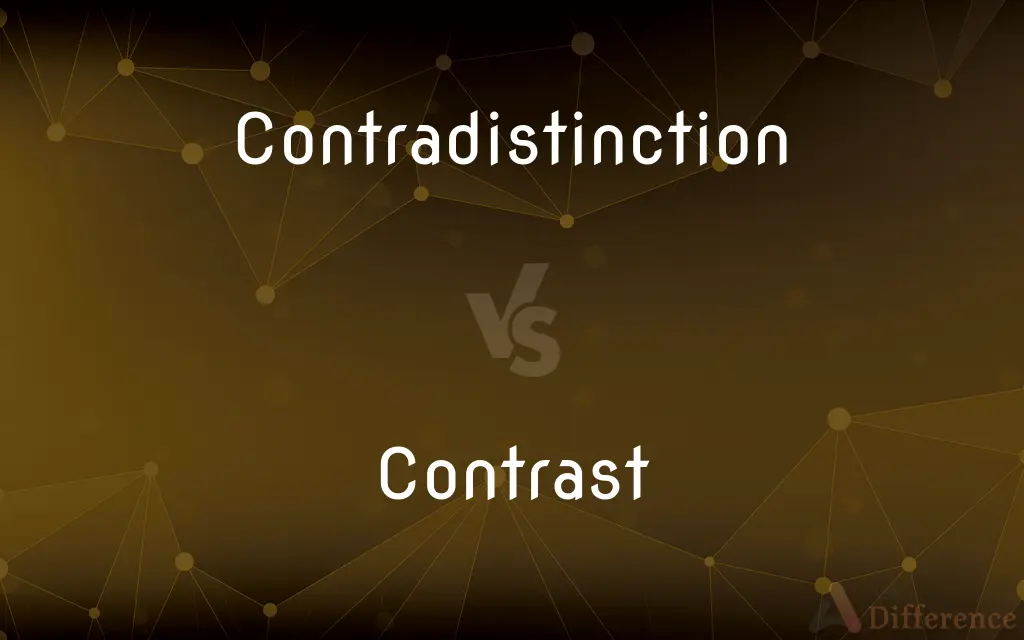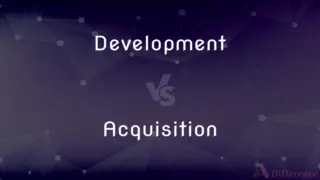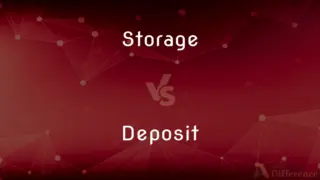Contradistinction vs. Contrast — What's the Difference?
Edited by Tayyaba Rehman — By Urooj Arif — Updated on March 28, 2024
Contradistinction refers to differentiation by contrasting characteristics, highlighting differences in detail, while contrast focuses on comparing two or more entities to show differences broadly.

Difference Between Contradistinction and Contrast
Table of Contents
ADVERTISEMENT
Key Differences
Contradistinction is a method of distinguishing two or more things by explicitly defining the characteristics that set them apart. It often involves a detailed and analytical approach to show how one entity is distinct from another on a fundamental or specific level. Contrast, on the other hand, is a broader comparison between entities to showcase their differences, which can be visual, thematic, or conceptual, without necessarily delving into detailed analysis.
In contradistinction, the emphasis is on the unique attributes that make something stand out from the rest, suggesting a deeper level of comparison that goes beyond surface-level observations. Whereas in contrast, the focus is more on the observable differences that are apparent without needing an in-depth examination, often used to draw attention to the diversity or disparity between things.
The use of contradistinction is common in academic, legal, and technical writings, where precise distinctions are crucial for clarity and understanding. Contrast, however, is widely used in everyday language, literature, art, and photography to highlight variations in a more general sense, making it accessible to a broader audience.
Contradistinction requires an understanding of the intricate details that define the uniqueness of each compared item, implying a more complex and nuanced analysis. In contrast, highlighting differences can be straightforward, relying on general characteristics or qualities that are easily perceived by the observer.
While contradistinction is a tool for in-depth differentiation and understanding, contrast serves as a method for creating visual or thematic appeal, emphasizing diversity or opposition in a way that is often more immediately recognizable to the viewer or reader.
ADVERTISEMENT
Comparison Chart
Definition
Differentiation by detailed characteristics
Comparison to show differences
Focus
Specific attributes that distinguish
Broad differences
Common Uses
Academic, legal, technical writings
Everyday language, arts
Level of Detail
High, analytical
Broad, general
Purpose
Clarify and define distinctions
Highlight diversity or disparity
Compare with Definitions
Contradistinction
Highlighting uniqueness by contrasting characteristics.
Contradistinction between the two proposals became evident through their budget allocations.
Contrast
To compare in order to show differences.
The artist used contrast to bring out the vibrant colors in the painting.
Contradistinction
A method to distinguish by direct comparison of specifics.
Legal texts often use contradistinction to clarify the nuances between terms.
Contrast
The act of distinguishing by comparing differences.
Literature often explores themes through the contrast of characters.
Contradistinction
A detailed analytical approach to showcasing differences.
The scientist's report provided a contradistinction of the new strain against known variants.
Contrast
A method for creating visual or thematic appeal.
Contrast in photography can make images more compelling.
Contradistinction
Clarification of differences by focusing on distinctive attributes.
The essay used contradistinction to explore the philosophies of realism and idealism.
Contrast
Highlighting diversity or opposition.
The novel's setting in contrast to its themes enriched the narrative.
Contradistinction
Differentiation by explicit contrast in detail.
In contradistinction, the professor highlighted the unique features of Renaissance and Baroque art.
Contrast
A noticeable difference between things being compared.
The contrast between the siblings' personalities was striking.
Contradistinction
Distinction by contrasting or opposing qualities.
Contrast
To set in opposition in order to show or emphasize differences
An essay that contrasts city and country life.
Contrasted this computer with inferior models.
Contradistinction
Distinction by contrast; the provision of one example against which another example may be defined.
We used hamburgers and soda in contradistinction to healthy food.
Contrast
To show differences when compared
Siblings who contrast sharply in interests and abilities.
A color that contrasted clearly with the dark background.
Contradistinction
The quality of being contradistinctive.
Contrast
(Linguistics) To evince a difference that can distinguish meaning
Voiced and voiceless stops contrast in English but not in Cree.
Contradistinction
Distinction by contrast.
That there are such things as sins of infirmity in contradistinction to those of presumption is not to be questioned.
Contrast
The act of contrasting; a setting off of dissimilar entities or objects.
Contradistinction
A distinction drawn on the basis of contrast;
Sculpture in contradistinction to painting
Contrast
The state of being contrasted
Red berries standing in vivid contrast against the snow.
Contrast
A difference, especially a strong dissimilarity, between entities or objects compared
The contrast between Northern and Southern speech patterns.
Contrast
One thing that is strikingly dissimilar to another
My new school was a welcome contrast to the one before.
Contrast
The use of opposing elements, such as colors, forms, or lines, in proximity to produce an intensified effect in a work of art.
Contrast
The difference in brightness between the light and dark areas of a picture, such as a photograph or video image.
Contrast
(Linguistics) A difference between units, especially one that distinguishes meaning.
Contrast
(countable) A difference in lightness, brightness and/or hue between two colours that makes them more or less distinguishable.
Contrast
(uncountable) The degree of this difference.
The red and the orange don't have much contrast between them — I can hardly tell them apart.
Contrast
(countable) A control on a television, etc, that adjusts the amount of contrast in the images being displayed.
Contrast
(countable) A difference between two objects, people or concepts.
Israel is a country of many contrasts.
Contrast
(countable) Something that is opposite of or strikingly different from something else.
Contrast
Antithesis.
Contrast
(transitive) To set in opposition in order to show the difference or differences between.
Contrast
(intransitive) To form a contrast.
Foreground and background strongly contrast.
Contrast
To stand in opposition; to exhibit difference, unlikeness, or opposition of qualities.
The joints which divide the sandstone contrast finely with the divisional planes which separate the basalt into pillars.
Contrast
To set in opposition, or over against, in order to show the differences between, or the comparative excellences and defects of; to compare by difference or contrariety of qualities; as, to contrast the present with the past.
Contrast
To give greater effect to, as to a figure or other object, by putting it in some relation of opposition to another figure or object.
The figures of the groups must not be all on side . . . but must contrast each other by their several position.
Contrast
The act of contrasting, or the state of being contrasted; comparison by contrariety of qualities.
Place the prospect of the soulIn sober contrast with reality.
Contrast
Opposition or dissimilitude of things or qualities; unlikeness, esp. as shown by juxtaposition or comparison.
The contrasts and resemblances of the seasons.
Contrast
The opposition of varied forms, colors, etc., which by such juxtaposition more vividly express each other's peculiarities.
Contrast
The opposition or dissimilarity of things that are compared;
In contrast to
By contrast
Contrast
The act of distinguishing by comparing differences
Contrast
A conceptual separation or demarcation;
There is a narrow line between sanity and insanity
Contrast
The perceptual effect of the juxtaposition of very different colors
Contrast
The range of optical density and tone on a photographic negative or print (or the extent to which adjacent areas on a television screen differ in brightness)
Contrast
Put in opposition to show or emphasize differences;
The middle school teacher contrasted her best student's work with that of her weakest student
Contrast
To show differences when compared; be different;
The students contrast considerably in their artistic abilities
Common Curiosities
Is contrast only visual?
No, contrast can be visual, thematic, conceptual, or textual, serving to highlight differences in a variety of contexts.
How does contradistinction benefit legal analysis?
Contradistinction benefits legal analysis by providing precise differentiation between concepts, terms, or cases, essential for legal clarity and decision-making.
What makes contradistinction unique in comparison to contrast?
Contradistinction is unique in its focus on detailed, specific attributes that distinguish one entity from another, requiring a deeper level of analysis.
Can contrast lead to a better understanding of the compared entities?
Yes, contrast can lead to a better understanding by highlighting the diversity or opposition between entities, though it may not provide as detailed an analysis as contradistinction.
Is contradistinction necessary for all forms of comparison?
Contradistinction is not necessary for all forms of comparison, especially when a general overview of differences is sufficient.
What is the main purpose of contradistinction?
The main purpose of contradistinction is to clarify and define the distinctions between entities by detailing their unique attributes.
How does one choose between using contradistinction or contrast?
The choice between contradistinction and contrast depends on the level of detail needed to convey the differences between the entities being compared.
Can contrast be used in academic writing?
Yes, contrast can be used in academic writing, though it typically serves to highlight broad differences rather than detailed analytical distinctions.
How do contradistinction and contrast complement each other?
While contradistinction provides a detailed analysis of differences, contrast highlights these differences in a broader sense, both contributing to a comprehensive understanding.
Why is contrast important in art and literature?
Contrast is important in art and literature as it creates visual or thematic appeal, emphasizing differences that enrich the viewer's or reader's experience.
Share Your Discovery

Previous Comparison
Development vs. Acquisition
Next Comparison
Storage vs. DepositAuthor Spotlight
Written by
Urooj ArifUrooj is a skilled content writer at Ask Difference, known for her exceptional ability to simplify complex topics into engaging and informative content. With a passion for research and a flair for clear, concise writing, she consistently delivers articles that resonate with our diverse audience.
Edited by
Tayyaba RehmanTayyaba Rehman is a distinguished writer, currently serving as a primary contributor to askdifference.com. As a researcher in semantics and etymology, Tayyaba's passion for the complexity of languages and their distinctions has found a perfect home on the platform. Tayyaba delves into the intricacies of language, distinguishing between commonly confused words and phrases, thereby providing clarity for readers worldwide.
















































